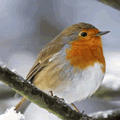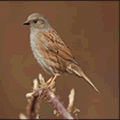The seafront gardens and surrounding area provide a habitat for a variety of smaller birds.
Here we look at some of the most popular birds and how you can help them when they visit your garden, particularly during the colder months.
To survive, some smaller bird species need to consume a large proportion of their own body weight in food every day, so providing the right high energy food for them has a very positive effect.
1. Robin

The Robin is the most frequently spotted winter garden bird. This little bird can be very aggressive when defending its territory. Robins occasionally nest in unusual and sometimes unsuitable places. In the garden they may choose a spot in a dense hedge or creeper quite close to the ground or they will use an open fronted nest box. They are mainly insect feeders, so a garden managed organically will enable them to find the food they need.
Supplementary food for robins:
– Fats
– Ground peanuts
– Mealworms
2. Blue Tit

The Blue Tit is naturally a woodland bird, but adapts well to using our gardens and is common in parks and urban areas. This species will be attracted to a garden with lots of small insects, including aphids living in the shrubs, trees and herbaceous plants. Being very agile, blue tits can cling to any hanging feeder and are tough enough to compete with the larger great tit. They will use a nest box on a tree or fence.
Supplementary food for Blue Tits:
– Sunflower seeds
– Peanuts
– Fats
3. Blackbird

The male Blackbird is familiar to everyone, with his wonderful fluting song, shiny black plumage and bright orange bill. In the garden blackbirds feed predominantly on soil invertebrates including earthworms, so a garden with flower beds and lawns will particularly attract them, as will berry bearing shrubs in the winter. They nest in thick shrubs and hedges and may take advantage of mild weather as early as February to lay their first eggs.
Supplementary food for Blackbirds:
– Fruit
– Raisins
– Kitchen scraps
4. Great Tit

The Great Tit is another familiar bird in gardens, parks and open spaces wherever there may be a tree. Boldly marked in black, yellow and blue, this adaptable bird enjoys our gardens for feeding and breeding, when a hole-fronted nest box will be readily used. Great tits are largely insect feeders and a garden managed to attract many invertebrates will naturally have its population of great tits. In the winter they feed in woodlands on insects and tree seeds, particularly beech nuts (mast).
Supplementary food for Great Tits:
– Sunflower seeds
– Peanuts
– Fats
5. Chaffinch

Chaffinches, the male with his attractive pink breast and slate blue head, spend much of their time feeding on the ground, often under seed feeders or bird tables. They are quite sedentary birds and the same individuals may be around in your garden for four or five years. They feed on insects and small seeds and build mossy nests in shrubs and hedges.
Supplementary food for Chaffinches
– Seeds
– Peanut pieces
6. Greenfinch

Greenfinches are primarily seed feeders, and can also be quite sedentary, often finding a spot on a seed feeder and apparently sitting there all day! The male’s breeding plumage is yellowy green, but becomes a dull olive green in the winter. Juveniles are streaky brown. This bird likes a thick hedge for nesting, even Leyland cypress if it is kept well clipped and dense.
Supplementary food for Greenfinches:
– Sunflower seeds
– Nyger seed
7. Dunnock

The Dunnock is the small brown bird that was once known as the hedge sparrow, but is not closely related to the house sparrow. Often overlooked, this little bird is actually very attractive with streaky grey and brown plumage and a fine pointed beak. It tends to feed on the ground, searching amongst leaves for insects and grubs but in the winter when these may be in short supply, seeds are a priority.
Supplementary food for Dunnocks:
– Nyger seed
– Sunflower hearts
– Grated cheese
– Breadcrumbs
8. Pied Wagtail

A small, long-tailed and rather sprightly black and white bird. When not standing and frantically wagging its tail up and down it can be seen dashing about over lawns or car parks in search of food. Main diet is insects. The tideline on the beach is a favoured feeding ground. It frequently calls when in its undulating flight.
Supplementary food for Pied Wagtails:
– Mealworms
9. Coal Tit

The tiny black and white coal tit can be recognised by the white stripe down the back of its head. It will use a nest box (with a very small opening) in a garden, especially one where there are conifers. Coal tits feed on small insects and seeds. They are more likely to be seen in gardens in the winter months, when they have a habit of taking seeds from feeders and hiding them for later use.
Supplementary food for Coal Tits:
– Sunflower seeds
– Peanut pieces
10. House Sparrow

The House Sparrow was once a common bird in our towns and cities, occurring in very large numbers. In the last 40 years, 50% of our sparrows have disappeared and although in the garden they will eat most types of food, they very much relied on grain in the winter time, in stubble fields and farmyards. This food resource has gone and this loss is a contributory factor in their decline. In the garden they will nest under house eaves, and the fact that many newer houses and offices no longer have these small spaces means that house sparrows are short of nest sites as well as food. They will use a nest box and prefer to nest communally, so boxes especially for them usually have space for several families.
Supplementary food for House Sparrows:
– Grain and seeds
– Kitchen scraps
Other smaller birds to look out for in the area include:
– Skylarks
– Song Thrushes
– Starling
– Wren
Supplementary feeding can be carried out throughout the year. The RSPB suggests the following, particularly in winter:
• Seeds
• Nuts
• Fat (not turkey fat)
• Fruit
• Invertebrates (e.g. mealworms)
• Unsalted bacon (cooked or uncooked)
• Grated cheese
You can also introduce plants that will attract the birds to your garden. For example:
• Hawthorn, ivy and honeysuckle will provide berries in winter for adult birds and insects for young birds in spring.
• Goat willow and dog rose will also attract insects.
• Once they are mature rowan, holly and apple trees are a great source of food for birds like blackbirds and thrushes, while robins and starlings will feast on the insects that thrive on them.
For more information about our local birdlife visit:
